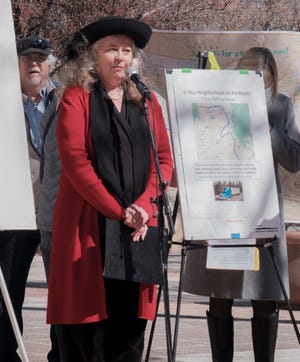PRESS CONFERENCE MAR. 1, 2022 - NEW MEXICANS SUPPORT GOVERNOR ACTING TO STOP WIPP EXPANSION
Adrian Hedden Carlsbad Current-Argus March 4, 2022 currentargus.com
“New Mexico agreed to host WIPP after carefully crafting agreements that limit what the federal government can do with it. It was afraid that this very thing would happen, and DOE didn’t disappoint,” she said Tuesday during a press conference in Santa Fe.
“WIPP’s mission can only be changed if the DOE breaks every legal agreement that it made with New Mexico in order to get it to host the WIPP site in the first place.”
Also concerning, Weehler said, was the transportation plan to ultimately bring the plutonium to WIPP.
Mostly originating at the Pantex Plant near Amarillo, Texas, the waste would first travel to Los Alamos National Laboratory (LAN) in northern New Mexico via truck for processing.
It would then be sent to the DOE’s Savannah River Site in South Carolina for additional packaging and preparation before heading back to New Mexico to WIPP in the southeast corner of the state.
Weehler said this transportation route brought danger to all communities along the way, pointing to signatures from residents throughout the state in opposition, and arguing residents in 11 states will be at risk.
“All of these communities will be at a higher level of risk because they’re on the radioactive transport route planned in the new Department of Energy mission to expand WIPP,” she said. “New Mexico has done its part. Our agreements should be honored. We made them in good faith, and the DOE should not be trying to pull a last-minute bait and switch by bringing waste to WIPP that wasn’t agreed to.”
Joining Weehler at the press conference was Santa Fe County Commissioner Anna Hansen, who said the waste would imperil those living along Interstate 40, U.S. Highway 285 and State Roads 599 and 502 which all pass through the Santa Fe areas.
She advocated for the DOE to focus on disposing of TRU waste generated at LANL at WIPP, providing a benefit, Hansen said, New Mexico was owed for hosting the repository.

During a recent interview with the Current-Argus, Todd Shrader, deputy assistant secretary of the DOE’s Office of Environmental Management, which operates the WIPP site, said there were no plans to expand WIPP’s acceptance criteria or the statutory volume limit of 6.2 million cubic feet.
To change that limit or the physical boundaries of WIPP would require an act of Congress.
Shrader said the dilute and dispose method was already underway at Savannah River and the waste would soon come to WIPP, similar to past waste accepted from the Rocky Flats facility in Denver.
“It is defense transuranic waste. It has to meet all of our waste acceptance criteria,” Shrader said. “It’s actually similar to waste we’ve taken in the past. A significant amount of planning has gone on. A lot of integration. There’s been a lot of briefings on it to make sure it’s ready to go.
“It generates a lot of interest, but it’s frankly similar to what we’ve done in the past. It’s maybe coming from a different source, not strictly a clean-up mission.”
Lujan Grisham’s press secretary Nora Meyers Sackett said the governor relayed the concerns with the DOE’s nuclear waste activities to U.S. Energy Secretary Jennifer Granholm.
“We fully expect the Department of Energy to meaningfully engage with stakeholders in New Mexico communities on this issue,” Sackett said.
“DOE must do a better job of earning their social license to operate from New Mexicans. Proposing to keep the facility open longer than planned and expanding the types of waste it accepts are contradictory to what the public and state signed up for when the WIPP was built.”
